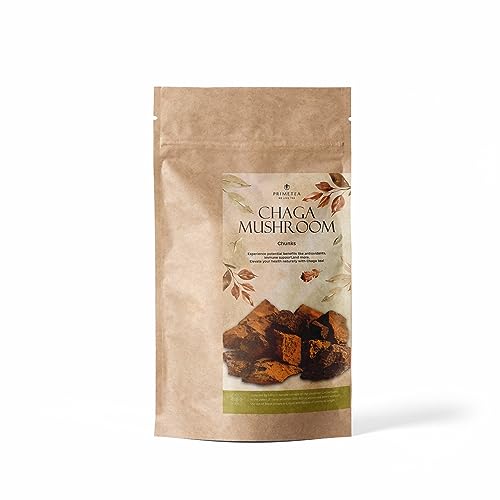We’ve discovered nature’s hidden treasure in the form of chaga mushrooms – those dark, crusty fungi that grow on birch trees in cold climates. Known as the “king of mushrooms,” chaga has been prized for centuries by indigenous peoples of Siberia and Northern Europe for its remarkable properties. This nutrient-dense superfood contains powerful antioxidants and compounds that make it one of nature’s most potent wellness allies.
Brewing chaga mushroom tea transforms this tough, woody fungus into a rich, earthy beverage that’s surprisingly smooth and coffee-like in flavor. Unlike other herbal teas, chaga offers a deep, satisfying taste that won’t overwhelm your palate with bitterness.
We’ll show you exactly how to prepare this ancient elixir at home using simple techniques that extract maximum benefits from your chaga chunks or powder. Whether you’re seeking a caffeine-free alternative to coffee or looking to incorporate more functional foods into your routine, this chaga tea recipe delivers both flavor and wellness in every cup.
What Is Chaga Mushroom Tea
Chaga mushroom tea transforms dried chaga chunks into a deeply nourishing beverage through careful steeping and brewing techniques. We prepare this antioxidant-rich drink by extracting the water-soluble compounds from the sclerotium, the hardened mass that forms on birch trees when chaga grows.
The brewing process releases beta-glucans, polyphenols, and essential minerals from the chaga’s tough exterior into hot water. Our finished tea displays a beautiful amber to dark brown color with an earthy, slightly bitter flavor profile that many describe as reminiscent of mild coffee or black tea.
Unlike traditional mushroom varieties found in grocery stores, chaga requires extended brewing time to unlock its beneficial compounds. We typically steep chaga pieces for 15 to 30 minutes to achieve optimal extraction and flavor development.
The resulting beverage contains no caffeine, making it an excellent choice for evening consumption or those avoiding stimulants. We appreciate how chaga tea provides sustained energy without the jitters or crashes associated with coffee.
Temperature plays a crucial role in proper chaga tea preparation. We maintain water temperatures between 160°F and 180°F to preserve heat-sensitive nutrients while effectively extracting the desired compounds from the fungal material.
Fresh chaga tea offers the most potent flavor and nutritional benefits, though we can store prepared tea in the refrigerator for up to one week. The same chaga chunks can be reused multiple times, with each brewing session producing a slightly lighter but still flavorful cup.
Health Benefits of Chaga Mushroom Tea
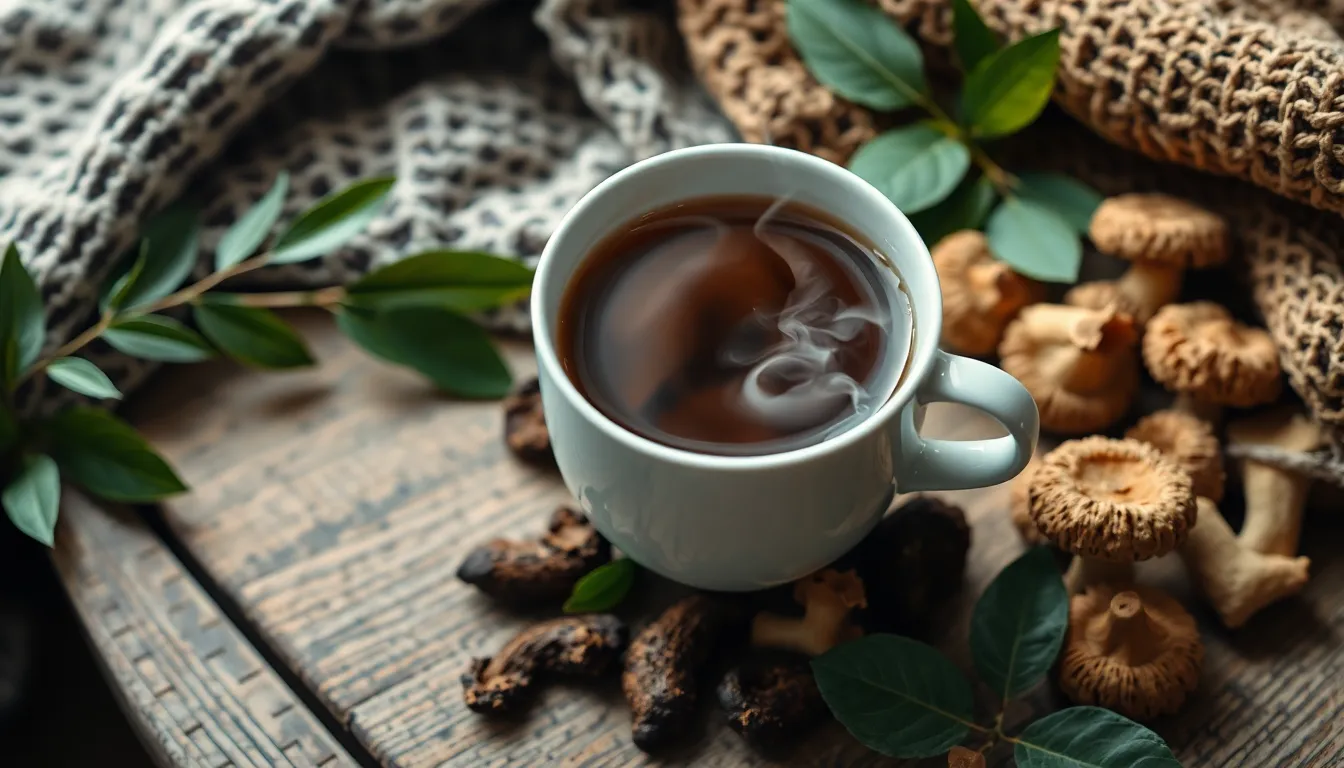
Chaga mushroom tea offers a remarkable array of health benefits that have been recognized through both traditional use and modern research. We’ve compiled the most important advantages this powerful fungus brings to our daily wellness routine.
Powerful Antioxidant Properties
Our bodies constantly battle oxidative stress, and chaga mushroom tea provides exceptional support through its rich antioxidant content. These natural compounds work to neutralize harmful free radicals that can damage our cells and contribute to aging and disease. The dark, coffee-like color of properly brewed chaga tea actually indicates the presence of these beneficial antioxidants.
Enhanced Immune System Support
Research indicates that chaga may help modulate immune function, potentially strengthening our body’s natural defense mechanisms. This immune-supporting quality makes chaga tea particularly valuable during seasonal changes or times when we need extra protection. The bioactive compounds in chaga work to balance immune responses rather than simply boosting them.
Natural Anti-Inflammatory Effects
Chronic inflammation underlies many health concerns, and chaga contains compounds that may help reduce inflammatory responses throughout our bodies. Regular consumption of chaga tea could support our overall inflammatory balance, contributing to better long-term health outcomes.
Adaptogenic Stress Relief
Chaga is often classified as an adaptogen, meaning it may help our bodies better manage and resist various forms of stress. This adaptogenic quality can support our ability to maintain balance during challenging times, whether physical, emotional, or environmental stressors.
| Benefit Category | Primary Effect | Research Status |
|---|---|---|
| Antioxidant | Reduces oxidative stress | Laboratory studies |
| Immune Support | Modulates immune function | Animal studies |
| Anti-Inflammatory | Decreases inflammation | Traditional use + studies |
| Adaptogenic | Helps resist stress | Traditional use |
We should note that while these benefits show promise, most research has been conducted in laboratory and animal studies. Clinical evidence in humans remains limited, and more research is needed to fully confirm these effects. Chaga is generally considered safe for most people when consumed in moderate amounts, though it may interact with certain medications or cause side effects in some individuals. We always recommend consulting with a healthcare provider before making important dietary changes, especially if you have existing health conditions or take medications.
Types of Chaga for Tea Making
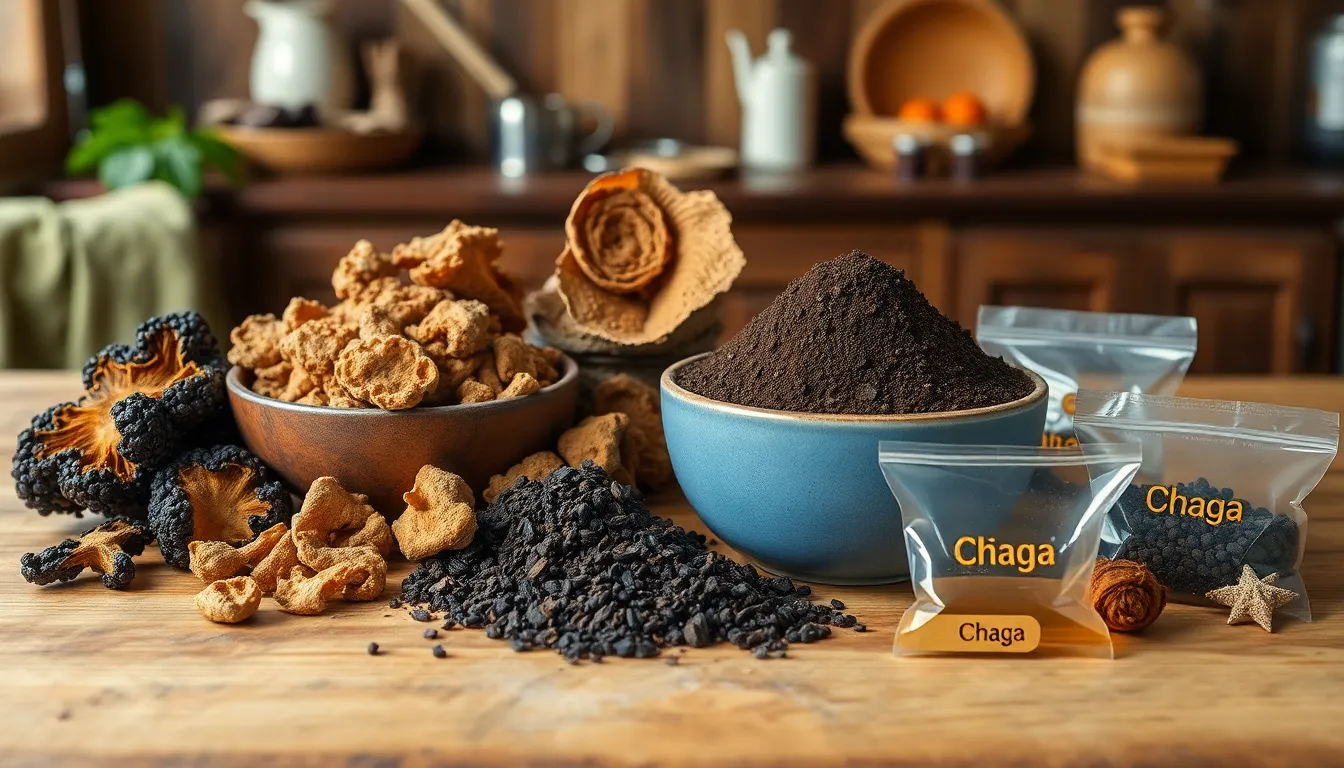
Understanding the different forms of chaga available helps us select the best option for our brewing preferences and desired potency. Each type offers unique advantages for creating this nutrient-rich beverage.
Dried Chaga Chunks
We consider dried chaga chunks the most potent and freshest form available for tea making. These large pieces come directly from chaga mushrooms harvested from birch trees and undergo careful cleaning before being broken into smaller brewing-sized portions. Fresh chunks retain maximum bioactive compounds and allow us to control the strength of our tea through extended brewing times. We can reuse the same chunks 2-5 times until they no longer produce a strong brew, making them an economical choice for regular chaga tea drinkers. The chunks require longer steeping periods but reward us with the most robust flavor and highest concentration of beneficial compounds.
Chaga Powder
Finely ground chaga mushroom creates a convenient option for quick tea preparation. This powdered form dissolves more readily in hot water and reduces our brewing time significantly compared to chunks. We find chaga powder particularly useful when we need faster preparation without sacrificing too much potency. The powder format allows for more precise measurement, with 2-4 teaspoons typically providing an optimal serving. While powder may be slightly less fresh than whole chunks, it still delivers substantial health benefits and creates a smooth, easily digestible tea.
Chaga Tea Bags
Pre-packaged chaga tea bags offer the ultimate convenience for busy schedules and travel. These bags contain powdered chaga mushroom that steeps quickly in hot water without requiring any handling of raw mushroom pieces. We can simply steep the bags for 10-15 minutes and enjoy immediate results. Tea bags provide consistent dosing and eliminate the need for straining, though they may have lower potency compared to fresh chunks. This format works perfectly for beginners or anyone seeking a hassle-free introduction to chaga mushroom tea.
Equipment Needed
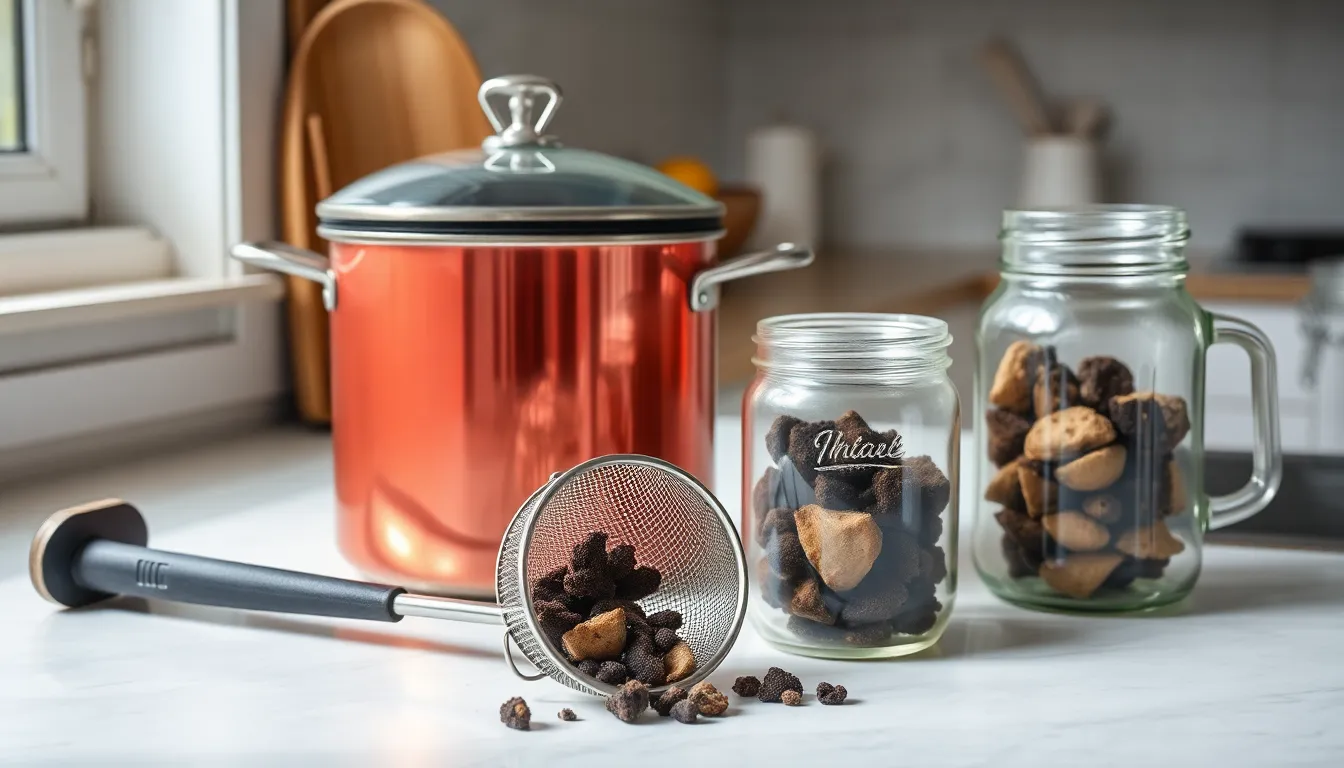
Creating the perfect chaga mushroom tea requires minimal equipment, making this ancient remedy accessible to any home brewer. We recommend gathering these essential tools before beginning your brewing process to ensure optimal extraction and convenience.
Soup pot with lid serves as our primary brewing vessel. A 4-quart pot provides ample space for proper water circulation around the chaga chunks while the lid prevents evaporation during the extended simmering process. The covered pot maintains consistent temperature and preserves the beneficial compounds we want to extract.
Hammer becomes useful when working with large chaga pieces. Breaking chaga into smaller chunks enhances extraction by increasing surface area exposed to hot water. We find that 1-inch by 1-inch pieces provide optimal extraction without creating particles too small to strain effectively.
Strainer or slotted spoon allows us to remove chaga chunks cleanly from the finished tea. A fine-mesh strainer captures any small particles while a slotted spoon works well for larger chunks. Both tools ensure our tea remains smooth and free of debris.
Jar or container for storing used chaga extends the value of each chaga purchase. Since chaga chunks can be reused 2 to 4 times, proper storage in the refrigerator maintains freshness between brewing sessions. We recommend using glass containers to avoid absorbing flavors or odors.
| Equipment | Purpose | Notes |
|---|---|---|
| 4-quart soup pot with lid | Primary brewing vessel | Maintains temperature and prevents evaporation |
| Hammer (optional) | Breaking large chaga chunks | Creates 1-inch pieces for optimal extraction |
| Strainer or slotted spoon | Removing chaga from tea | Fine-mesh preferred for smooth results |
| Storage jar | Preserving used chaga | Glass containers work best for freshness |
These simple tools transform dried chaga into a nourishing beverage while maximizing the extraction of water-soluble compounds. Having everything prepared before starting ensures a smooth brewing process and consistent results with each batch.
Ingredients
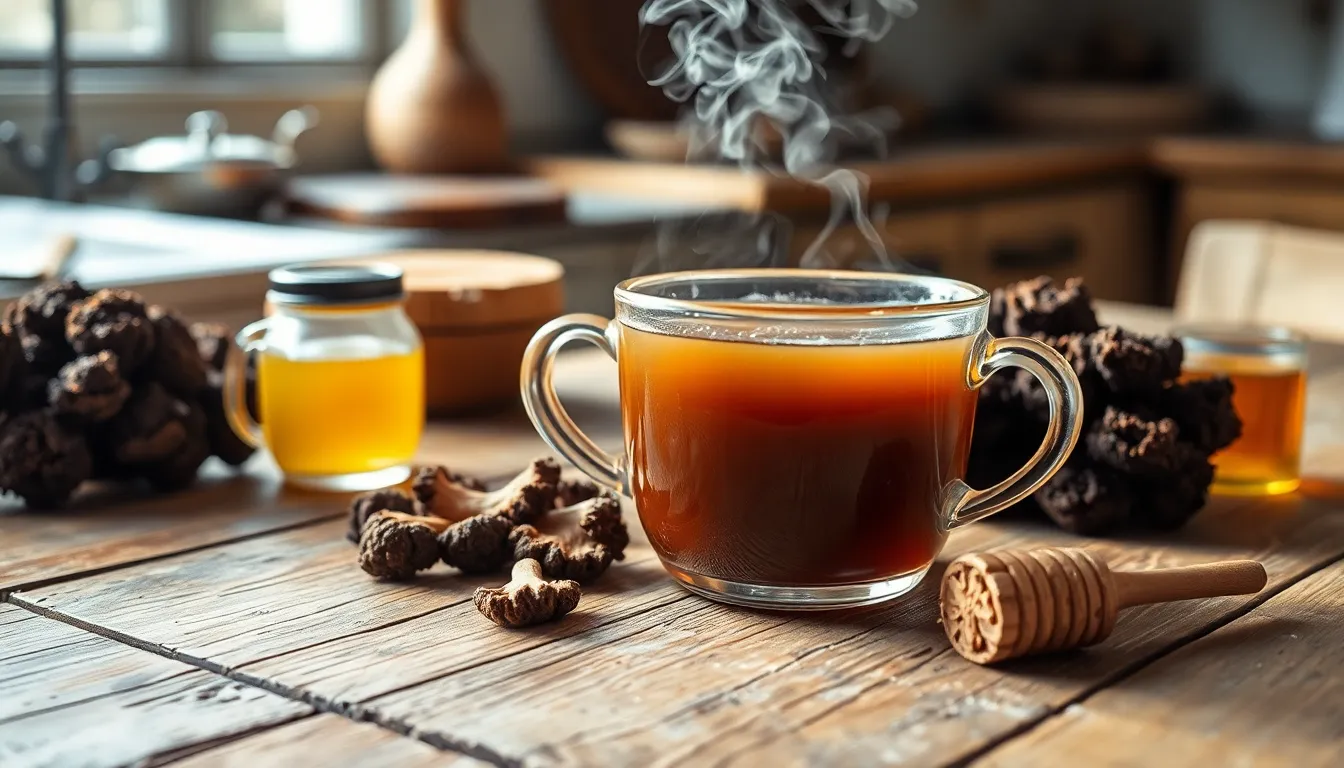
We need surprisingly few ingredients to create this nutrient-dense chaga mushroom tea. The simplicity of our ingredient list makes this ancient remedy accessible to anyone looking to incorporate this powerful adaptogen into their daily routine.
For our standard batch, we require:
- ½ oz dried chaga mushrooms – This amount provides the perfect concentration for extracting beneficial compounds while allowing for multiple brews from the same chunks
- 8 cups filtered water – Clean water ensures optimal flavor extraction and prevents any impurities from interfering with the tea’s natural taste
For a smaller serving, our ingredients scale down to:
- 1 tablespoon chaga powder – Powder form offers convenience and faster brewing when we need a quick cup
- 4 cups filtered water – This reduced quantity creates 2-3 servings of concentrated chaga tea
Fresh chaga mushrooms work equally well in our recipe if we have access to wild-harvested specimens. We recommend using the same measurements as dried chaga since fresh varieties maintain similar potency levels.
Our optional flavor enhancers include:
- Raw honey or pure maple syrup – Natural sweeteners complement chaga’s earthy profile without masking its beneficial properties
- Coconut milk or oat milk – Adding milk creates a coffee-like beverage that satisfies those transitioning from traditional caffeinated drinks
The beauty of chaga tea lies in its ingredient simplicity. We don’t need complex additions or specialty items to create this wellness-promoting beverage. Quality chaga and pure water form the foundation of our recipe, while optional enhancements allow us to customize the tea according to our taste preferences.
Instructions
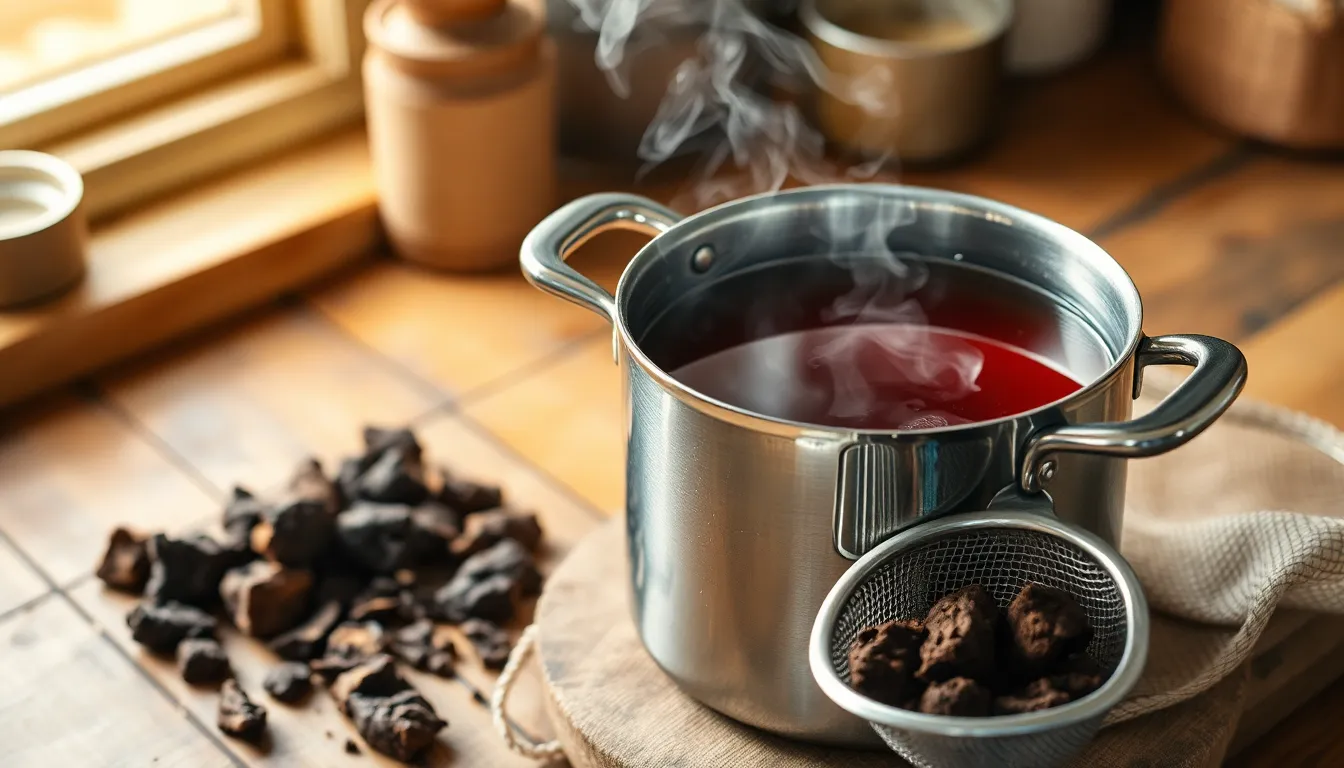
Creating the perfect chaga mushroom tea requires patience and attention to detail during each brewing stage. We’ll walk you through the complete process from preparation to serving.
Prep the Chaga
We start by measuring our dried chaga chunks or nuggets. For a standard batch we use ½ oz of chaga pieces paired with 8 cups of filtered water. Golf ball sized chunks work best as they require only 2-4 pieces while larger nuggets need just 1-2 pieces for optimal extraction.
Breaking larger pieces into smaller chunks ensures better water penetration and more efficient brewing. We avoid using powder for our initial preparation since chunks offer easier straining and multiple reuses. Each chunk can be reused 2-4 times until the tea no longer darkens the water.
Store any used chunks in the refrigerator or freezer between brewing sessions. This preservation method maintains their potency for subsequent batches and maximizes the value of your chaga investment.
Simmer the Tea
We combine our prepared chaga chunks with filtered water in our brewing pot. The ratio remains consistent at ½ oz chaga to 8 cups water or 1 cup of small chunks to 1 gallon for larger batches.
Bringing the mixture to a boil marks the beginning of our extraction process. We immediately reduce heat to achieve a low simmer rather than maintaining a rolling boil. This gentle approach preserves the delicate nutrients and beneficial compounds within the chaga.
Our simmering time extends for at least 30 minutes to allow proper extraction. The water transforms into a dark reddish-brown or black tea color indicating successful compound release. For stronger potency we can extend simmering up to 4 hours depending on desired strength and chunk size.
| Chunk Size | Simmering Time | Batch Size |
|---|---|---|
| Small chunks | 15-30 minutes | Standard |
| Powder | 1 hour | Any size |
| Large chunks | 2-4 hours | Large batches |
Strain and Serve
We remove all chaga chunks by straining the finished tea through a fine mesh sieve. This step ensures a smooth drinking experience without any residual particles.
Serving immediately while hot delivers the most satisfying experience. We can enhance the flavor with raw honey or pure maple syrup according to personal preference. Adding coconut milk or other plant-based alternatives creates a coffee-like substitute for those seeking variety.
Leftover tea stores well in the refrigerator for up to 7 days. We can enjoy it cold or gently reheat portions as needed. The used chaga chunks continue providing value through multiple brewing cycles until they lose their color and flavor intensity.
Brewing Methods

We’ve discovered that different brewing methods unlock varying levels of chaga’s beneficial compounds and flavors. Each technique offers unique advantages depending on your schedule and desired tea strength.
Stovetop Method
We recommend starting with ½ ounce of dried chaga chunks (approximately 4-5 pieces) combined with 8 cups of filtered water in a large pot. Cover the pot and bring the mixture to a gentle simmer over medium heat.
Reduce the heat to low and maintain a steady simmer for at least 30 minutes for basic extraction. For maximum potency and deeper flavor we suggest extending the simmering time to 2-3 hours. The longer brewing period allows more beneficial compounds to extract into the water.
Remove the chaga chunks using a strainer or slotted spoon once brewing is complete. Your tea can be served immediately while hot or refrigerated for later use. We’ve found that the same chaga chunks remain effective for 2-4 additional brewing sessions using this same process.
Slow Cooker Method
Place your chaga chunks and water using the same ratio as the stovetop method directly into your slow cooker. Set the temperature to low and allow the mixture to brew for 4-6 hours without lifting the lid.
This extended cooking time creates a stronger and more medicinally concentrated brew compared to shorter methods. The consistent low heat maintains optimal extraction temperatures throughout the entire process.
Strain out the chaga chunks when brewing is finished and serve your tea hot or store it in the refrigerator. We appreciate this hands-off approach when preparing large batches for the week ahead.
Cold Brew Method
Fill a large jar with chaga chunks and water using similar proportions to our stovetop technique. Cover the jar securely and let it steep at room temperature for 2-3 days for moderate strength.
For enhanced extraction we recommend refrigerating the mixture and allowing it to steep for up to one full week. Cold brewing naturally extracts fewer bitter compounds while still drawing out beneficial nutrients.
Strain the liquid to remove all chaga pieces before drinking your chilled tea. This method produces a smoother and less bitter flavor profile that many people prefer during warmer months.
Flavor Enhancement Options

While chaga mushroom tea offers a naturally rich and earthy flavor profile, we can easily customize this beneficial beverage to suit our personal taste preferences. The following enhancement options allow us to create delicious variations while preserving all the health benefits of our freshly brewed chaga tea.
Natural Sweeteners
We recommend incorporating natural sweeteners to balance the slightly bitter notes of chaga tea without compromising its nutritional value. Raw honey serves as our top choice, providing antimicrobial properties alongside gentle sweetness that complements the earthy mushroom flavors. Pure maple syrup offers another excellent option, delivering complex flavors with trace minerals that enhance the overall drinking experience.
Both sweeteners should be added after brewing while the tea remains warm, allowing them to dissolve completely. We suggest starting with one teaspoon per cup and adjusting according to personal preference, as too much sweetness can mask the distinctive chaga flavor profile.
Spice Additions
Citrus additions transform our chaga tea into a bright and refreshing beverage perfect for any time of day. Fresh lemon, lime, or orange wedges add vitamin C and natural acidity that cuts through the robust mushroom notes. We find that half a wedge per cup provides the ideal balance without overwhelming the base flavors.
Ginger powder or freshly chopped ginger root creates warming spice notes that pair beautifully with chaga’s earthy characteristics. Start with a pinch of ginger powder or a small piece of fresh ginger during the brewing process to infuse the entire batch. Vanilla bean powder adds sophisticated sweetness and aromatic complexity, requiring only a small amount to enhance the overall flavor profile significantly.
Milk Alternatives
Plant based milk alternatives create creamy, latte style chaga beverages that appeal to those seeking richer textures. Almond milk provides subtle nutty flavors that complement the mushroom base without competing for attention. Soy milk offers neutral creaminess with added protein content, making our chaga tea more substantial and satisfying.
Oat milk delivers natural sweetness and velvety texture that transforms chaga tea into an indulgent treat resembling traditional coffee drinks. We recommend adding 2-4 tablespoons of any milk alternative per cup, warming it separately before combining with the hot chaga tea to prevent curdling. These creamy variations work especially well when served in the evening as caffeine free alternatives to traditional milk based beverages.
Storage and Make-Ahead Tips
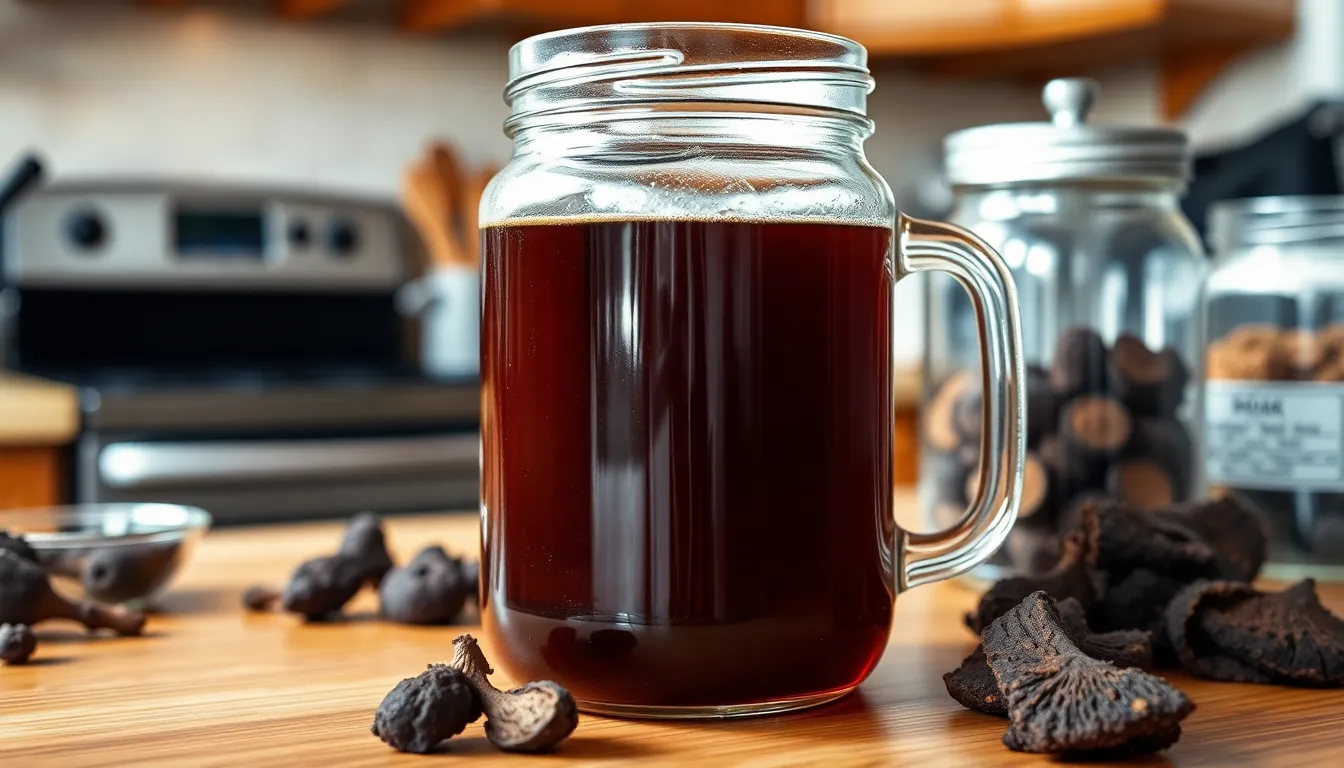
Proper storage techniques help us maximize the value of our chaga tea while ensuring we always have this beneficial beverage ready when needed. These strategies allow us to prepare larger batches efficiently and maintain the tea’s potency over time.
Storing Brewed Tea
Once we’ve strained our finished chaga tea, transferring it to a clean jar or airtight container preserves its quality and flavor. Our brewed tea stays fresh in the refrigerator for up to one week, giving us plenty of time to enjoy multiple servings from a single batch.
When we’re ready to drink our stored tea, gentle reheating maintains the beneficial compounds that make chaga so valuable. We avoid boiling the tea again since high temperatures can degrade the antioxidants and other health-promoting properties we worked to extract during the initial brewing process.
Room temperature storage works for same-day consumption, but refrigeration becomes essential for longer storage periods. Glass containers work best since they don’t absorb flavors or odors that might affect our tea’s taste profile.
Preparing Chaga in Advance
The beauty of chaga lies in its reusability, allowing us to extract maximum value from each purchase. After our first brew, we can store the used chaga chunks in the refrigerator submerged in water, keeping them ready for our next batch without starting the preparation process from scratch.
| Reuse Cycle | Expected Strength | Storage Method |
|---|---|---|
| 1st Use | Full strength | Fresh chunks |
| 2nd Use | 80% strength | Refrigerated in water |
| 3rd Use | 60% strength | Refrigerated in water |
| 4th Use | 40% strength | Refrigerated in water |
These stored chunks retain their brewing power for 2-4 additional uses, with each subsequent batch producing progressively lighter tea until the chunks lose their color and flavor. We know it’s time to replace our chaga when the brewing water no longer turns the characteristic dark reddish-brown to black color.
For ultimate convenience, we can keep chaga powder stored dry in an airtight container, ready to simmer for about an hour whenever we want fresh tea. This approach works particularly well for busy schedules since powder requires less preparation time than breaking down whole chunks.
Our make-ahead strategy extends beyond just storing used chunks. We can prepare concentrated chaga tea by using less water during brewing, then diluting individual servings as needed. This concentration method saves refrigerator space while providing the flexibility to adjust strength according to our daily preferences.
Serving Suggestions
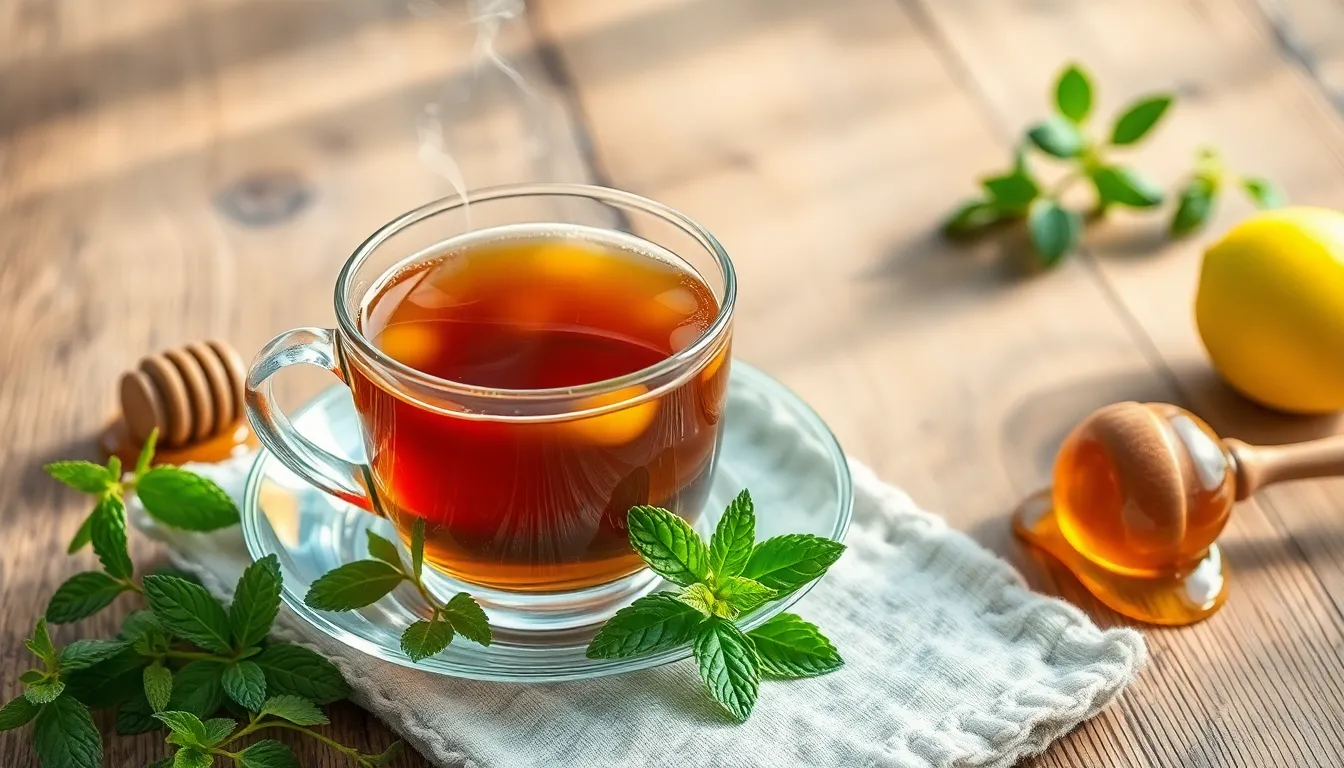
We recommend enjoying chaga mushroom tea as a warm, comforting beverage on its own to fully appreciate its rich earthy flavor profile. The natural taste provides a grounding experience that many find meditative and calming.
Adding honey transforms the slightly bitter notes into a balanced and pleasant drink. Raw honey works particularly well because it complements the tea’s natural compounds without overpowering the distinctive chaga flavor. Maple syrup offers another excellent sweetening option that enhances the tea’s earthy characteristics.
We suggest serving chaga tea as part of a relaxing evening routine since it contains no caffeine. This makes it an ideal replacement for coffee or traditional teas when you want to unwind without stimulating effects. The tea pairs beautifully with quiet moments of reflection or gentle stretching.
Creating a tea blend opens up many possibilities for customization. Fresh mint leaves add a cooling element that brightens the overall flavor. Lemon balm provides subtle citrus notes while maintaining the tea’s calming properties. These herbs complement chaga’s natural taste without competing for dominance.
For those who prefer creamier beverages, we recommend adding plant-based milk alternatives. Coconut milk creates a rich, tropical twist that pairs surprisingly well with chaga’s earthiness. Oat milk produces a smooth, latte-style drink that feels indulgent yet remains healthful.
Serving chaga tea at different temperatures reveals unique flavor dimensions. Hot preparation emphasizes the tea’s warming qualities and releases aromatic compounds most effectively. Cold serving creates a refreshing alternative that works well during warmer weather or as a post-workout beverage.
We find that chaga tea makes an excellent base for wellness shots. Concentrate the brew by reducing water quantities during preparation, then serve in small portions for a potent health boost. This concentrated version delivers maximum benefits in a manageable serving size.
Troubleshooting Common Issues
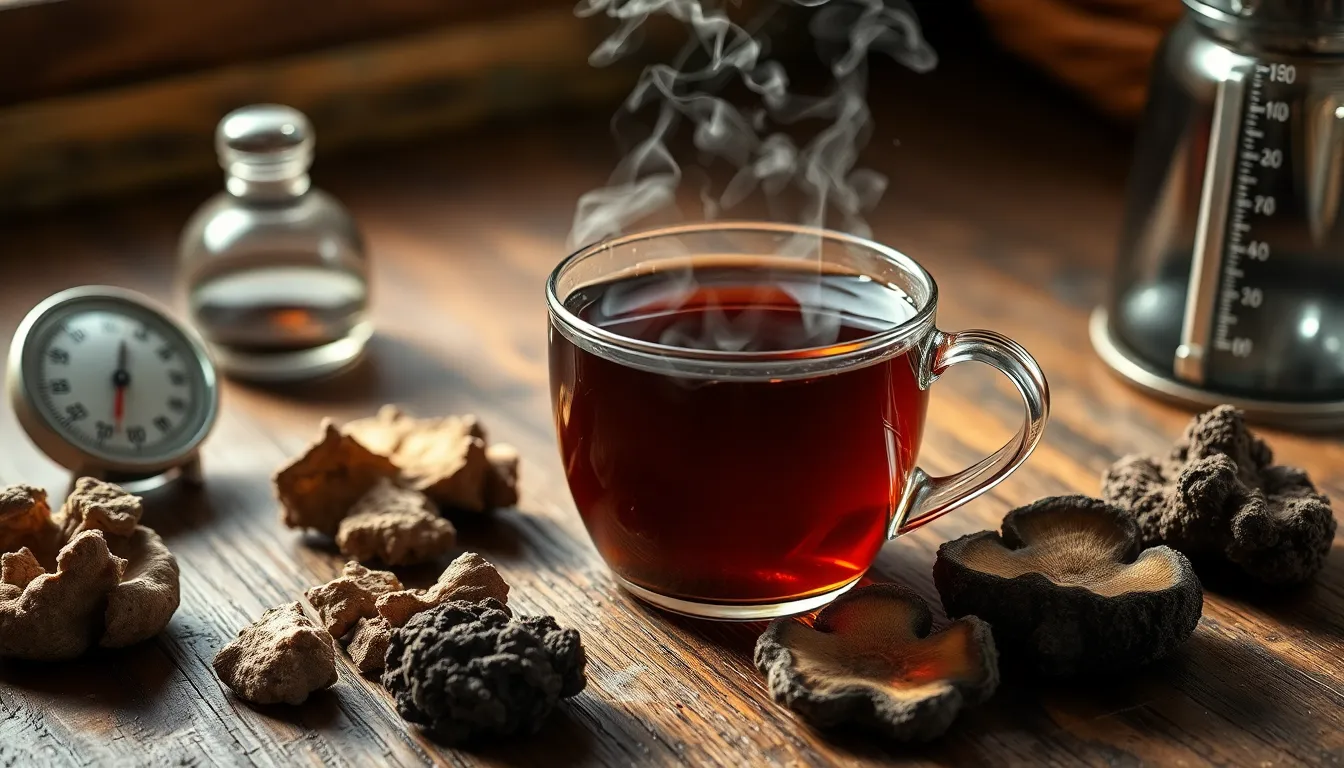
Brewing chaga mushroom tea can present some challenges for beginners. We’ve compiled answers to the most common problems you might encounter during your tea-making journey.
Tea Tastes Too Weak
When your chaga tea lacks the rich earthy flavor you expected, several factors could be at play. We recommend increasing your steeping time from 30 minutes to 2-3 hours for stronger extraction. The chunk size also matters significantly – larger pieces require longer brewing times to release their beneficial compounds effectively.
Check your chaga-to-water ratio if weakness persists. For a standard batch, use ½ oz of dried chaga with 8 cups of water. Reduce the water amount to 6 cups for a more concentrated brew while maintaining the same chaga quantity.
Tea Tastes Overly Bitter
Excessive bitterness often results from overextraction or water temperature issues. We suggest reducing your simmering time to 30-60 minutes rather than the maximum 4-hour brewing period. Keep your water at a gentle simmer rather than a rolling boil to prevent harsh compounds from leaching into your tea.
Adding natural sweeteners like raw honey or pure maple syrup can balance the bitter notes without compromising health benefits. Start with one teaspoon per cup and adjust according to your taste preferences.
Water Temperature Problems
Maintaining proper water temperature proves crucial for optimal extraction. We recommend keeping your water between 160°F and 180°F throughout the brewing process. Boiling water destroys valuable antioxidants and creates an overly bitter flavor profile.
Use a thermometer to monitor temperature if you’re struggling with consistency. Reduce heat immediately when bubbles form around the pot edges to maintain the ideal simmering temperature.
Chaga Chunks Breaking Apart
Large chaga pieces sometimes crumble during extended brewing sessions. We suggest breaking your chaga into golf ball-sized chunks before brewing to prevent excessive fragmentation. Wrap smaller pieces in cheesecloth to contain any debris while still allowing proper extraction.
Store your chaga in a dry location to prevent moisture-related deterioration that leads to crumbling. Properly stored dried chaga maintains its structure through multiple brewing cycles.
Reusing Chaga Effectively
Many home brewers struggle with determining when chaga chunks lose their potency. We recommend tracking your brews – quality chaga typically produces 2-4 strong infusions before flavor diminishes significantly. The tea color provides an excellent indicator – when your brew appears pale yellow rather than deep reddish-brown, your chaga has reached its extraction limit.
Label your used chaga with brewing dates to track usage effectively. Store spent chunks in the refrigerator between uses to maintain freshness and prevent spoilage.
Storage and Freshness Issues
Improper storage leads to diminished tea quality and potential spoilage. We store our brewed chaga tea in airtight glass containers in the refrigerator for up to one week maximum. Avoid plastic containers that can absorb flavors and compromise taste.
Fresh chaga tea should maintain its rich color and earthy aroma throughout the storage period. Discard any tea that develops off odors or shows signs of cloudiness, as these indicate bacterial growth.
Conclusion
We’ve equipped you with everything needed to master the art of brewing chaga mushroom tea at home. From selecting the right chaga form to perfecting your brewing technique this ancient wellness drink is now within your reach.
The journey from raw chaga chunks to a perfectly brewed cup doesn’t require complicated equipment or extensive experience. With patience and the right approach you’ll consistently create this nutrient-rich beverage that’s been treasured for centuries.
Remember that each brewing session is an opportunity to fine-tune your technique and discover your preferred flavor profile. Whether you’re seeking a morning wellness ritual or an evening wind-down drink chaga tea adapts beautifully to your lifestyle and taste preferences.
Frequently Asked Questions
What is chaga mushroom tea?
Chaga mushroom tea is a nutrient-rich beverage made from the sclerotium of chaga mushrooms that grow on birch trees in cold climates. Often called the “king of mushrooms,” chaga has been used traditionally by indigenous peoples of Siberia and Northern Europe. The tea is made by simmering dried chaga chunks in hot water, extracting beneficial compounds to create an earthy, coffee-like drink that’s caffeine-free and packed with antioxidants.
What are the main health benefits of chaga tea?
Chaga tea is renowned for its powerful antioxidant properties that help neutralize free radicals and combat oxidative stress. It may enhance immune system support, provide natural anti-inflammatory effects, and act as an adaptogen to help the body manage stress. However, most research has been conducted in laboratory and animal studies, with limited clinical evidence in humans, so it’s advisable to consult a healthcare provider before making significant dietary changes.
How long should I brew chaga mushroom tea?
Chaga tea requires extended steeping times of 15-30 minutes for basic brewing, though some methods involve simmering for 30 minutes to 3 hours depending on your preferred strength. The stovetop method typically takes 30 minutes to 3 hours, while slow cooker brewing takes 4-6 hours. Cold brew methods can steep for 2-7 days, producing a smoother flavor profile with different beneficial compound concentrations.
What water temperature is best for brewing chaga tea?
The optimal water temperature for brewing chaga tea is between 160°F and 180°F. This temperature range is crucial for preserving the beneficial nutrients while effectively extracting the water-soluble compounds from the chaga. Water that’s too hot can destroy delicate compounds, while water that’s too cool won’t properly extract the beneficial elements, resulting in weak tea with reduced health benefits.
Can I reuse chaga chunks for multiple brews?
Yes, chaga chunks can be reused for multiple brews, making them economical and sustainable. The same chaga pieces can typically be used 3-5 times, though each subsequent brew will have diminishing strength and potency. Store used chaga chunks in the refrigerator between uses and monitor for any signs of spoilage. This reusability is one of the advantages of using dried chaga chunks over powder or tea bags.
How should I store brewed chaga tea?
Brewed chaga tea can be stored in an airtight container in the refrigerator for up to one week. When reheating, use gentle heat to preserve the beneficial compounds. For convenience, you can prepare concentrated chaga tea and dilute it as needed. Always check for signs of spoilage before consuming stored tea, and use glass or food-grade containers for optimal freshness and quality preservation.
What does chaga tea taste like?
Chaga tea has a rich, earthy flavor profile that’s often described as coffee-like with slightly bitter notes. The taste is smooth and deeply nourishing, without the harshness sometimes associated with medicinal teas. Many people find the flavor pleasant on its own, though it can be enhanced with natural sweeteners like honey or maple syrup, citrus additions, spices like ginger, or plant-based milk for a latte-style drink.
What equipment do I need to brew chaga tea?
The essential equipment for brewing chaga tea includes a 4-quart soup pot with a lid for optimal brewing, a hammer for breaking large chaga pieces into smaller chunks, a strainer or slotted spoon for removing chaga from the tea, and a storage jar for preserving used chaga. These basic tools ensure effective extraction of beneficial compounds and help maintain the quality of your tea throughout the brewing process.
Is chaga tea caffeine-free?
Yes, chaga mushroom tea is completely caffeine-free, making it an excellent alternative to coffee and suitable for evening consumption. This makes it ideal for people who want to avoid stimulants or those sensitive to caffeine. You can enjoy chaga tea at any time of day without worrying about it affecting your sleep patterns, while still benefiting from its rich antioxidant content and potential health benefits.
What’s the difference between chaga chunks, powder, and tea bags?
Dried chaga chunks are the most potent and freshest form, allowing control over tea strength and multiple reuses. Chaga powder offers convenience for quicker preparation but may have slightly less potency than chunks. Pre-packaged chaga tea bags provide ultimate convenience for busy schedules but typically have the lowest potency. Each form caters to different needs, with chunks being best for maximum benefits and tea bags for convenience.




